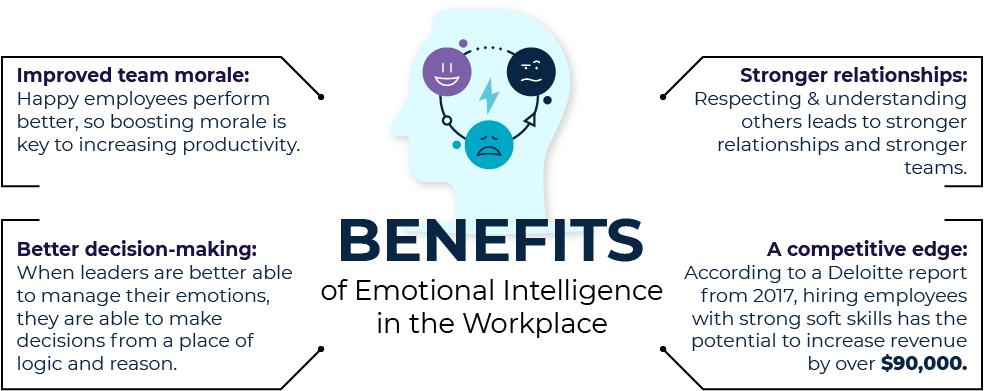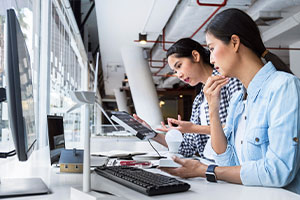In Brief
- Building Positive Environment: Leaders cultivating emotional intelligence foster a culture of respect, collaboration, and innovation, creating a positive, productive work environment.
- Enhanced Relationship and Productivity: Emotional intelligence facilitates better relationships, collaboration, and productivity, enabling leaders to manage emotions effectively in themselves and others.
- Strategies for Growth: By practicing self-awareness, active listening, seeking feedback, showing empathy, and expressing gratitude, leaders can improve emotional intelligence, fostering better communication and stronger teamwork.
Building a positive and productive work environment has a significant impact on organizational success and development. Leaders must be able to recognize, understand and manage emotions in themselves and others to foster a successful work environment. With practical strategies, leaders can build emotional intelligence and create a culture of respect, collaboration and innovation in the workplace where everyone feels valued and appreciated.

It also includes the ability to use that information to guide decision-making and create positive outcomes. Emotional intelligence is considered to be a separate concept from, and more important than, IQ – meaning that someone very intelligent may not be very emotionally intelligent.
Emotional intelligence is essential in the workplace because it facilitates collaboration, productivity and positive relationships. It can be developed, and there are many strategies you can use to do so. By growing your EQ, you can improve your career, your relationships, and your life overall. To grow your EQ, you must understand how emotions work, how they affect people, and what you can do to manage your emotions and the emotions of others.
Benefits of Emotional Intelligence in the Workplace
Emotions have a significant impact on the workplace in many ways. Employees who are unhappy at work are less productive, more likely to quit and have higher healthcare costs due to stress-related illnesses.
There are many benefits to building a culture of emotional intelligence in the workplace, including:

Understanding the Impact of Emotions
Leaders need to understand how an employee’s emotions could impact their work. How an employee feels in the moment can greatly affect their ability to do their job – and their ability to interact with others. For example, if an employee is feeling overwhelmed and needs assistance, it’s not helpful to tell them to “snap out of it.” This dismissive response ignores the employee’s feelings and does not address the root cause of the issue.
A more effective approach would be for the leader to recognize the employee’s emotion and respond in a way that is empathetic and supportive. This might involve asking the employee how they are feeling, offering resources or assistance, or finding ways to alleviate their workload. By acknowledging and addressing the employee’s emotions, a leader can create a more positive and supportive work environment for their team.
The SAFE-G Method
Here’s a simple framework I’ve learnt over the years to keep in touch with my own emotions and how they are impacting my interactions with others at work. I call it the SAFE-G zone!
- Start with self-awareness: When you are able to recognize your own emotions and understand why you feel a certain way, you can better manage and regulate them. This self-awareness can also help you be more attuned to the emotions of your team and respond in a more empathetic and supportive way.
For example, you might take a few minutes at the beginning of each day to reflect on your own emotions and how they might affect your interactions with your team. You might ask yourself: “How am I feeling today? How might my emotions impact my interactions with my team?”
- Use active listening: When someone is speaking, give them your full attention and try to understand their perspective. This can help you better recognize and respond to their emotions.
For example, when someone is speaking to you, you might give them your full attention and try to understand their perspective. You might say: ” I would be greatly interested in hearing your thoughts on this topic. Could you elaborate on your perspective for me?”
- Seek feedback: Ask for feedback from your co-workers and manager about how you can improve your emotional intelligence. This can provide valuable insights and help you identify areas for growth.
For example, you might ask your team for feedback on how you can improve your emotional intelligence. You might say: “I value your input and I’m committed to growing as a leader. Can you give me any feedback on how I can better recognize and understand the emotions of my team?”
- Show empathy: Make an effort to put yourself in others’ shoes and understand their emotions. This can help build trust and strengthen relationships at work.
For example, you might make an effort to put yourself in your team’s shoes and understand their emotions. You might say: “That must have been really challenging for you. How are you feeling about it?”
- Practice gratitude: Expressing gratitude and appreciation for your co-workers can help create a positive work environment and improve overall morale.
For example, you might express appreciation and gratitude for your team by saying: “I just wanted to let you know how much I appreciate all of your hard work and dedication. Thank you for all that you do.”
How to Build Emotional Intelligence in the Workplace
Building a culture of emotional intelligence is a process that requires leaders to increase self-awareness, manage stress and create an inclusive environment where open communication is encouraged. To create a healthy work environment that effectively addresses and manages emotions, you can try implementing these strategies:

Conclusion
In conclusion, emotional intelligence is an important aspect of building healthy and productive relationships in the workplace. By practicing self-awareness, seeking feedback, using active listening, showing empathy, and expressing gratitude, leaders and employees can improve their emotional intelligence and create a more positive and supportive work environment. Emotional intelligence can help foster better communication, stronger teamwork, and increased productivity, ultimately benefiting the entire organization. By making a conscious effort to develop their emotional intelligence, leaders and employees can contribute to the overall success of their team and organization.
References:
How to Improve Your Emotional Intelligence – Professional Development | Harvard DCE
How to Develop Emotional Intelligence Skills | HBS Online
5 Ways To Develop Your Emotional Intelligence (forbes.com)
Making the most of your learning style: Emotional intelligence | Help Centre | The Open University
EQ in the workplace: 6 ways high EQ employees boost productivity (ehl.edu)











